|
|
Created/dedicated as per personal communication with Carol Carpenter, May 18, 2011
Updated as per James P. Tuttle's The Hawk Moths of North America, May 18, 2011
Updated as per personal communication with Kevin McCollum (Erinnyis lassauxi, Fort Worth, Tarrant County, December 19, 2012); December 19, 2012
|
Northeastern Texas
Sphingidae
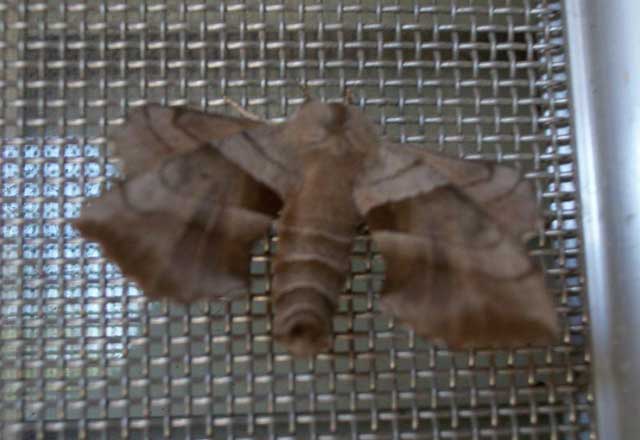
Amorpha juglandis, Granbury, Hood County, Texas,
May 18, 2011, courtesy of Carol Carpenter.
This page is inspired by and dedicated to
Carol Carpenter who sent me the picture of the
Amorpha juglandis male from Granbury (Hood County) at the
top of this page.
Carol writes, "I found the hawkmoth on my front porch in Granbury Texas."
Many thanks also to Jillian Burrows who sends the following image of Ceratomia undulosa from her area. Jill writes,
"I've contacted you in the past regarding the identification of sphinx moths I had come across while living in the Austin, Texas area. Your website has been truly
very informative and of great help when I've gotten the opportunity to raise larvae. All your work on these sites is awe-inspiring!
"This morning I came across a mating pair in the driveway; I'm uncertain of what they are, but felt inclined to send you a photo. I've never seen a pair before,
and now I hope to find eggs and/or larvae on the vine food source in the backyard - yay! The photo was taken in Mansfield in southern Tarrant County, Texas.
If any more information is needed, please feel free to contact me with any other questions and comments, thank you. I have left the photo in its original size.
you may want to crop if necessary."
I reply, "Thanks for thinking of me, Jill. The moths (Ceratomia undulosa, the Waved Sphinx) are quite susceptible to predators while pairing. I suspect the female hatched from an underground pupa
whose larva fed on a nearby ash tree or a lilac or privet bush. This species is not one of the vine feeders.
"The female will readily lay eggs in an inflated green paper lunch bag, once the pair has separated. She is probably carrying over 200 eggs, so you will probably want to release her
after you have obtained some eggs from her. Best of luck."
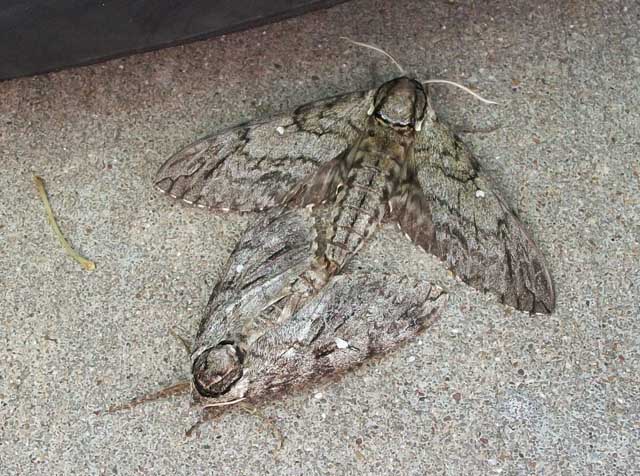
Ceratomia undulosa pairing, Mansfield, Tarrant County, Texas,
August 25, 2011, courtesy of Jillian Burrows.
Seventy-five Sphingidae species are listed for Texas on the U.S.G.S.
website. Not all of the species are reported or anticipated in
the northcentral region.
It is hoped that this checklist, with the thumbnails and notes, will help you
quickly identify the moths you are likely to encounter.
Please help me develop this list with improved, documented accuracy
by sending sightings (species, date, location), preferably with an
electronic image, via email to
Bill Oehlke.
The night-blooming moon flower will attract many
Sphingidae at dusk and into the night.
Many thanks to Kevin McCollum who provides images of Erinnyis laussauxi, not previously recorded in Tarrant County. This is probably a late fall stray from
further south.
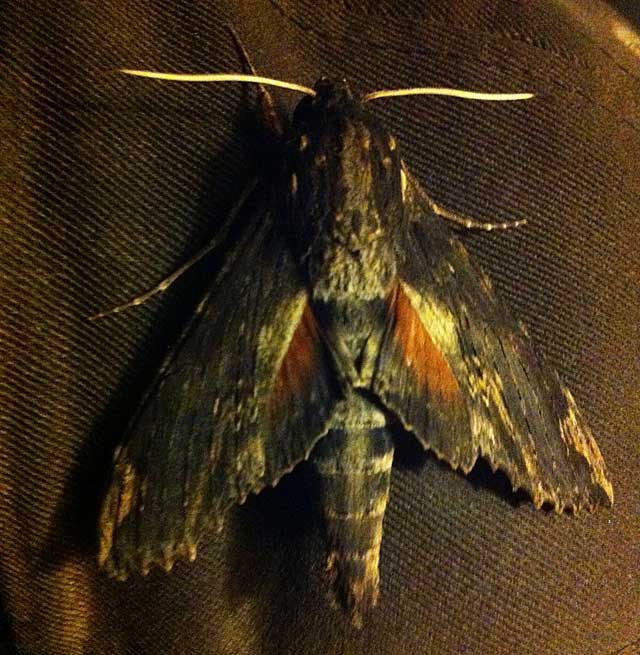
Erinnyis lassauxii, Fort Worth, Tarrant County, Texas,
December 19, 2012, courtesy of Kevin McCollum.
Sphinginae subfamily
Sphingini tribe:
 |
This species is a strong migrant and adults nectar from
deep-throated flowers including moonflower (Calonyction aculeatum),
morning glory (Convolvulus), honey suckle (Lonicera)
and petunia (Petunia species). generally more southerly
|
 |
Ceratomia amyntor,
the Elm Sphinx or Four-horned Sphinx
The upperside of the forewing is brown with dark brown and white markings including a white costal area near the wing base, dark streaks along the veins,
and a white spot in the cell.
Larvae feed on Elm (Ulmus), birch (Betula), basswood (Tilia), and
cherry (Prunus). generally more easterly |
 |
The upperside of the forewing is yellowish brown with no white markings, but there are indistinct black lines and dashes.
The cell spot is gray with a black outline. The larvae feed in large groups and are much more
spectacular than the moths.
Catalpa is the larval host. generally more easterly
|
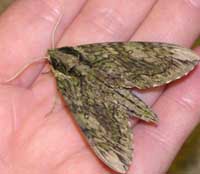 |
Ceratomia hageni,
Hagen's Sphinx or Osage Orange Sphinx
The upperside of the forewing is gray with a green tint and has dark
indistinct wavy lines, and pale gray patches at the wing tip and
along the costa. generally more easterly |
 |
The upperside of the forewing is pale brownish gray with wavy black and white lines and a black-outlined white cell spot.
The upperside of the hindwing is gray with diffuse darker bands.
|
Ceratomia undulosa, Mansfield, Tarrant County, August 25, 2011, Jill Burrows.
 |
Dolba hyloeus, the Pawpaw Sphinx
The upperside of the forewing is dark brown with a dusting of white
scales. Some moths have patches of reddish or yellowish brown on the
wings.
|
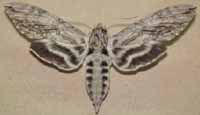 |
The upperside of the forewing is pale gray with a yellowish tint,
wavy black lines and dashes, and inconspicuous white spots.
|
 |
I suspect if you grow tomatoes, you are likely to encounter Manduca quinquemaculatus.
|
 |
Look for three large yellow spots
on each side of the abdomen. The upperside of the forewing is
yellowish brown to deep chocolate brown with a dusting of white
scales and zigzagged black and white lines. There is also a rare dark form larva.
generally more easterly
|
 |
If you grow tomatoes, you have probably encountered Manduca sexta
in the larval stage.
Larvae get very large and can strip a tomato plant.
|
 | The upperside of the forewing is gray with indistinct black and
white markings. There is a series of black dashes
from the base to the tip, and a small white cell spot.
|
Smerinthini Tribe:
 |
The adults are also highly variable; sometimes wings of an individual
may be all one color or may have several colors, ranging from pale to
dark brown, and may have a white or pink tinge. Patterns range from
faint to pronounced.
See the file for the female; she is different.
|
Amorpha juglandis, Granbury, Hood County, Texas, May 18, 2011, Carol Carpenter.
 |
They are common on Prince Edward Island, but are not often reported in Texas.
|
Macroglossinae subfamily
Dilophonotini tribe:
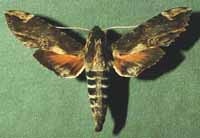 |
This moth flies in Haiti and Jamaica south to Paraguay and Bolivia
with occasional sightings in Texas and Arizona.
|
Erinnyis lassauxii, Fort Worth, December 19, 2012, Kevin McCollum.
See Hemaris comparison to help distinguish
the next two species.
 |
It is not difficult to see why many gardeners would mistake an
Hemaris thysbe moth for a small hummingbird as it hovers,
sipping nectar from flowers through a long feeding tube.
generally more eastern species
|
 |
Hemaris diffinis, the
Snowberry Clearwing or Bumblebee Moth
Adults mimic bumblebees and are quite variable. The wings are basically clear, with dark brown to
brownish-orange veins, bases and edges. The thorax is golden-brown to
dark greenish-brown. The abdomen tends to be dark (black) with 1-2
yellow segments before the tip.
|
Philampelini tribe:
 |
Larvae get large and feed on grape vines and Virginia creeper.
Note the differences between this moth and the Pandorus Sphinx. |
Macroglossini tribe:
 |
This day flier is widely distributed. If you have Virginia Creeper, you
probably have the Nessus Sphinx. Two bright, distinct, narrow yellow
bands are often visible on the abdomen.
|
 |
Darapsa myron, the Virginia Creeper Sphinx or the Grapevine Sphinx
If you have the
foodplants indicated in the common names, you probably have this
species nearby. The lower wings are orange.
|
 |
This species has
strong migrating tendancies from much further south.
There are records from New Hampshire and Maine.
|
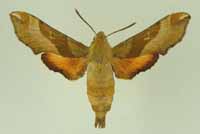 |
The rare and possibly endangered Proud Sphinx flies from Texas and
Louisiana east to northern Florida, north to Alabama, Missouri,
northern Georgia, and South Carolina. rare
|
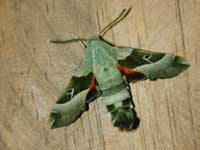 |
The upperside of the forewing is pale gray-green with a deep
green-brown median area and a white dash at the wing tip.
rare
|
 |
The upperside of the forewing is pale brown with lavender-gray at the
base and has dark brown lengthwise lines throughout. The upperside of
the hindwing is dark brown with a band of whitish, wedge-shaped marks.
|
|
|
Use your browser "Back" button to return to the previous page.
This page is brought to you by
Bill Oehlke and the
WLSS. Pages are on space rented from Bizland. If you would like
to become a "Patron of the Sphingidae Site", contact Bill.
Please send sightings/images to Bill. I will do my best to respond to
requests for identification help.
Enjoy some of nature's wonderments, giant silk moth cocoons.
These cocoons are for sale winter and fall. Beautiful Saturniidae moths will emerge the following spring and summer.
Read Actias luna rearing article.
Additional online help available.
Eggs of many North American species are offered during the spring and summer. Occasionally
summer Actias luna and summer Antheraea polyphemus cocoons are available. Shipping to US destinations is done
from with in the US.
Use your browser "Back" button to return to the previous page.
This page is brought to you by
Bill Oehlke and the
WLSS. Pages are on space rented from Bizland. If you would like
to become a "Patron of the Sphingidae Site", contact Bill.
Please send sightings/images to Bill. I will do my best to respond to
requests for identification help.
 | 
Show appreciation for this site by clicking on flashing butterfly to the left.
The link will take you to a page with links to many insect sites. |
This website has been created and is maintained by Bill Oehlke without government or institutional financial assistance. All expenses, ie., text reference
support material, webspace rental from Bizland, computer repairs/replacements, backups systems, software for image adjustments (Adobe Photoshop; L-View),
ftp software, anti-virus protection, scanner, etc. are my own.
I very much appreciate all the many images that have been sent to me, or of which I have been granted permission to copy and post from other websites.
All images on this site remain the property of respective photographers.
If you would like to contribute to the maintenace of this website by sending a contribution to
Bill Oehlke
Box 476
155 Peardon Road
Montague, Prince Edward Island, C0A1R0
Canada
your donation would be much appreciated and would be used for
1) paying for webspace rental;
2) paying for computer maintenance and software upgrades;
3) purchases of additional text reference material (journals and books) in anticipation of expanding the site to a worldwide Sphingidae site;
4) helping to pay my daughter's tuition; with anything left over going to humanitarian aid.
If you are mailing a check from USA, please use $0.85 postage. Donations can also be made through Paypal via the button below.




